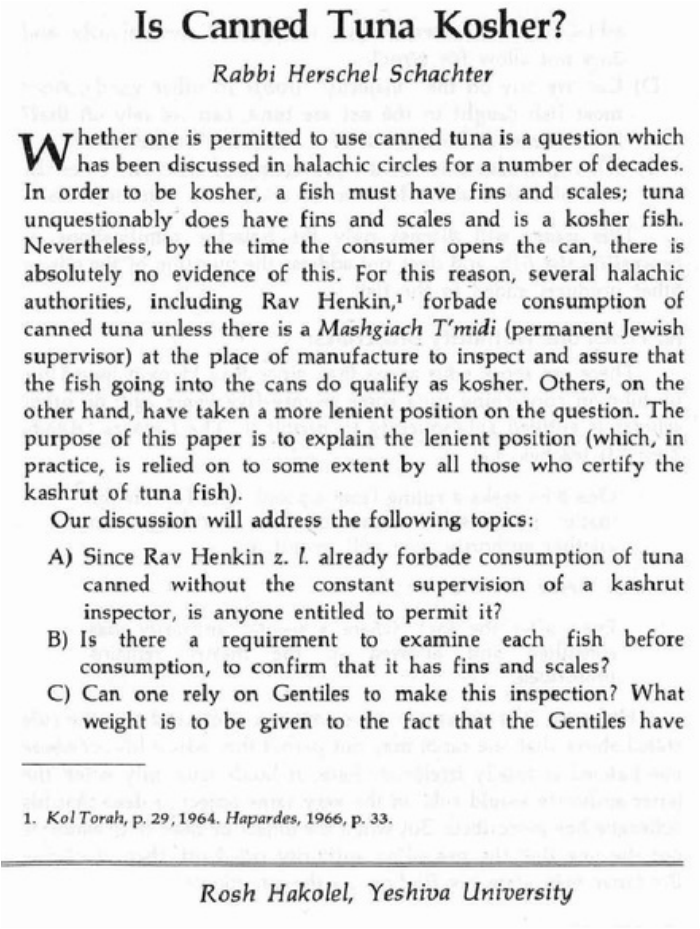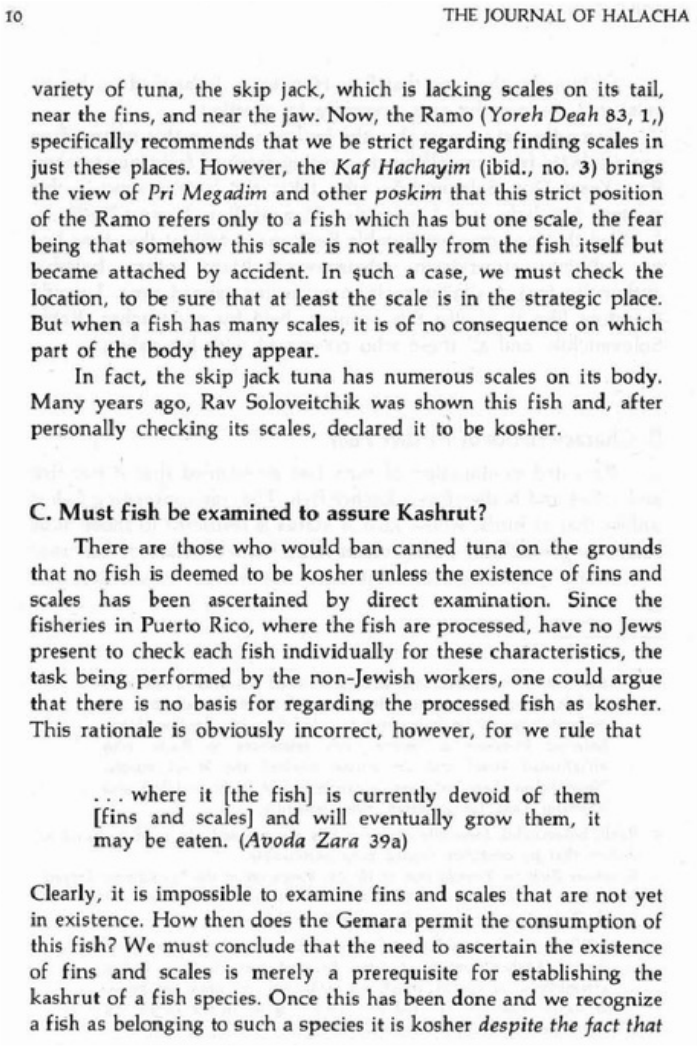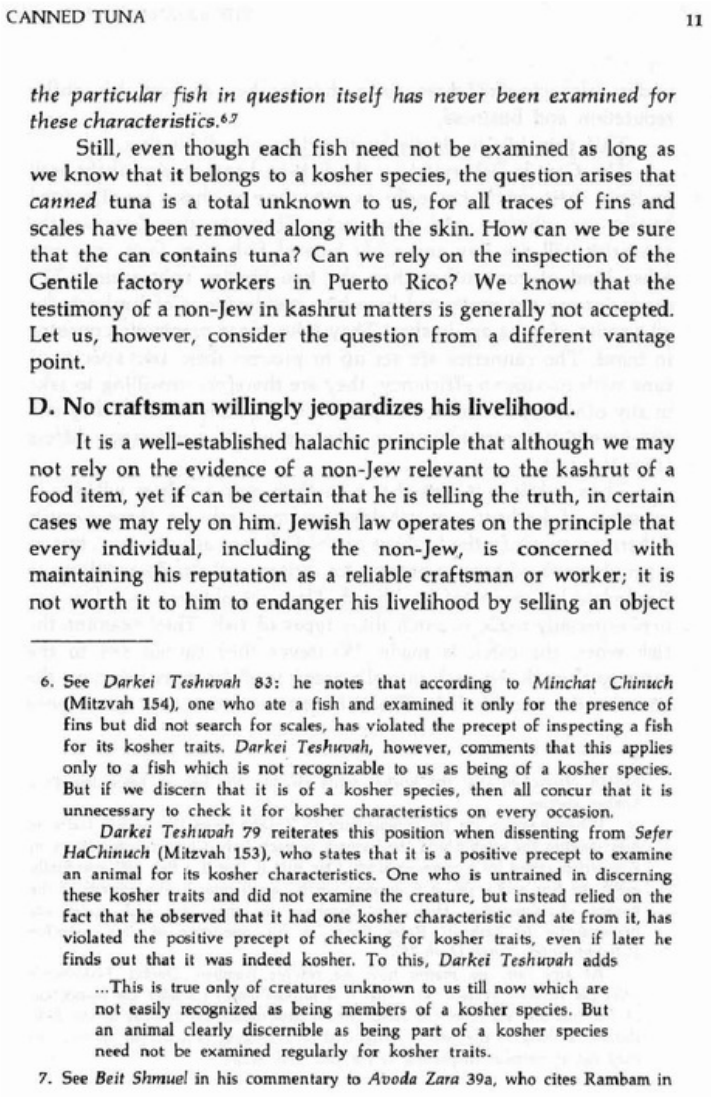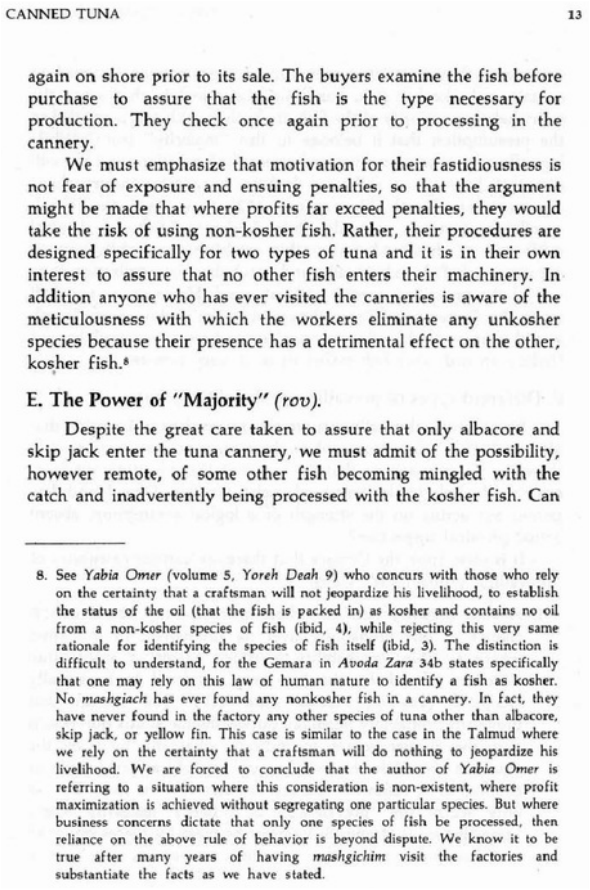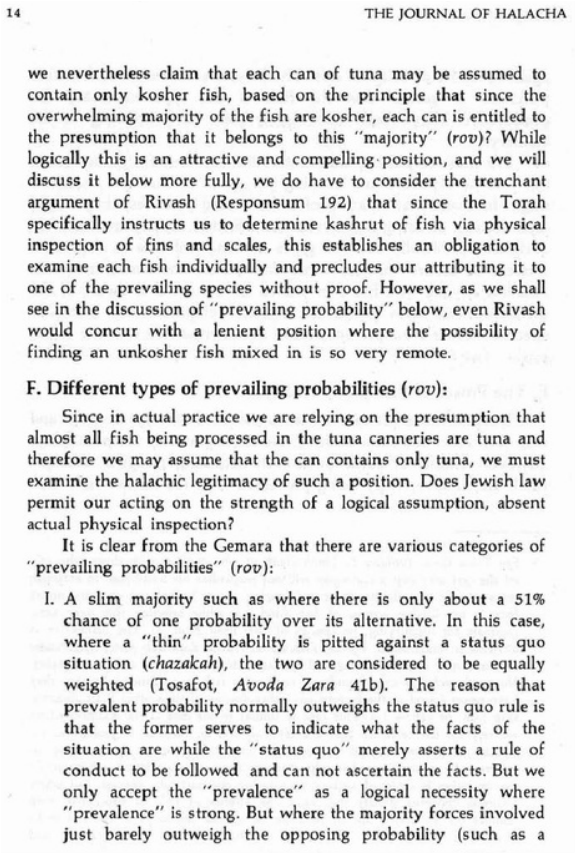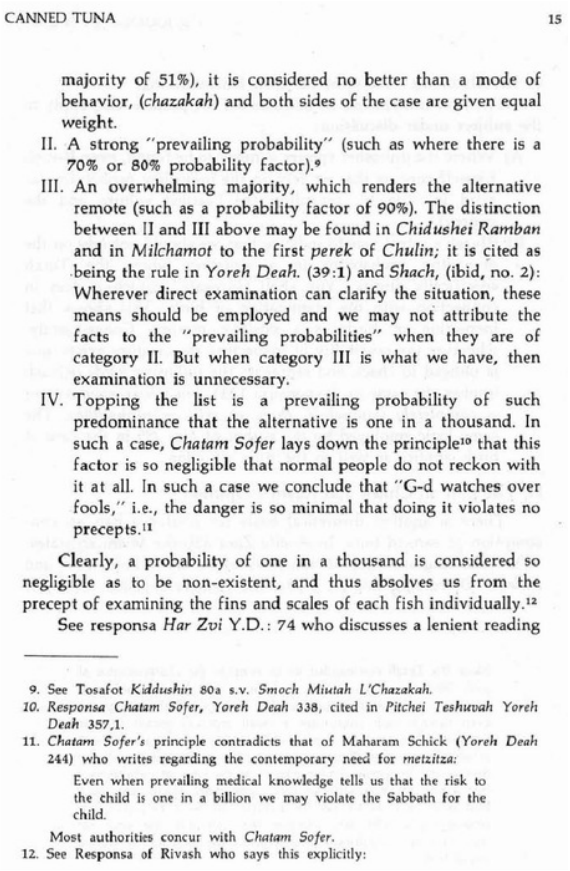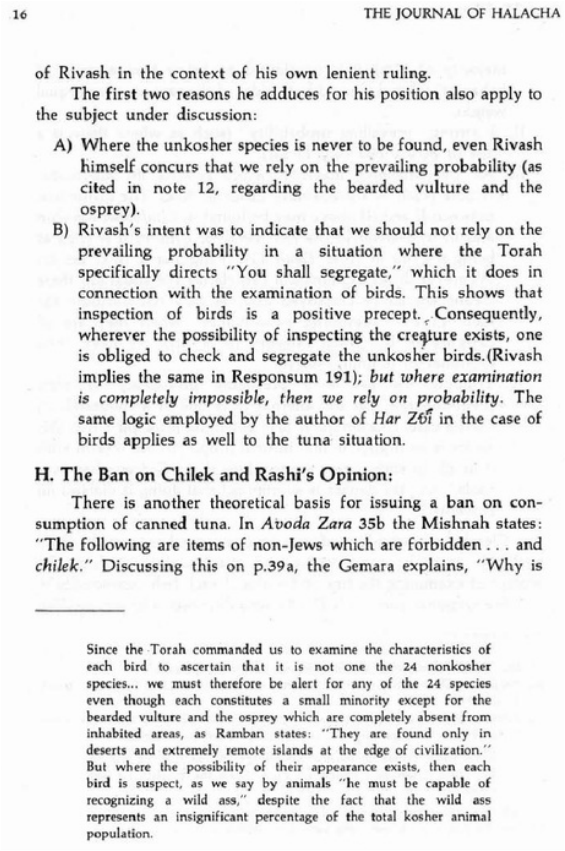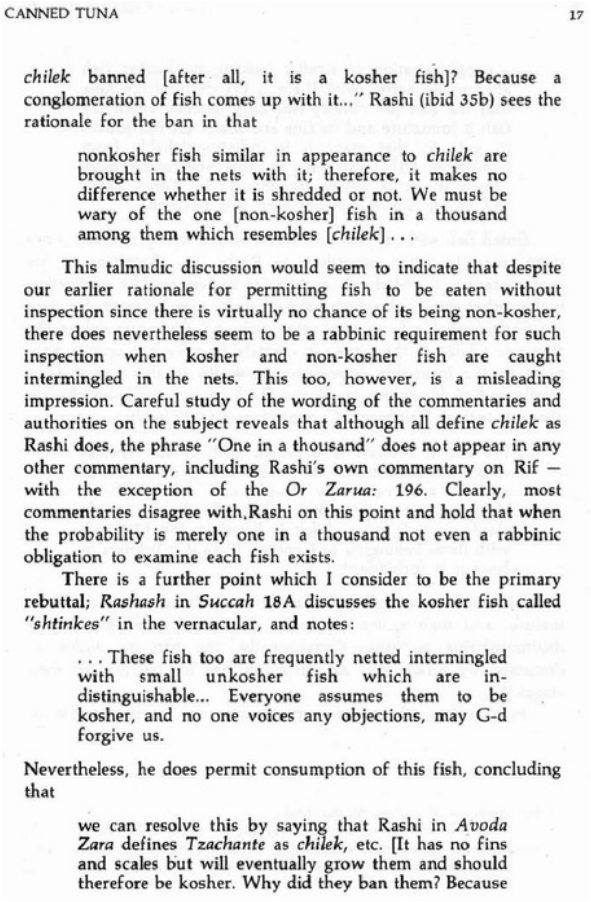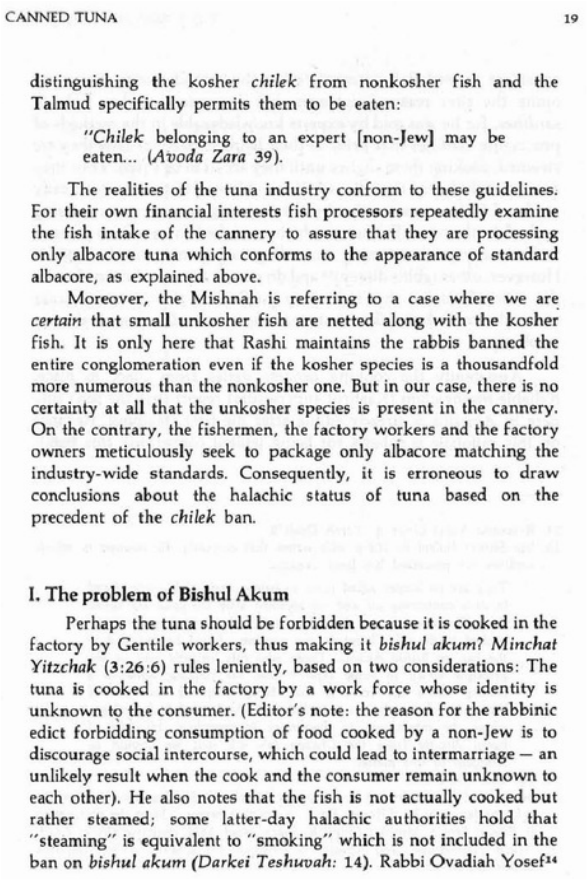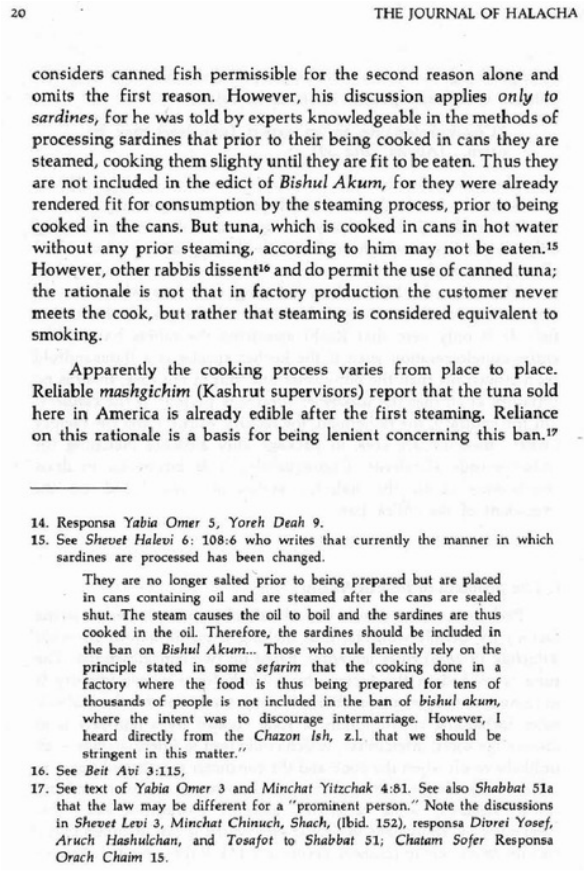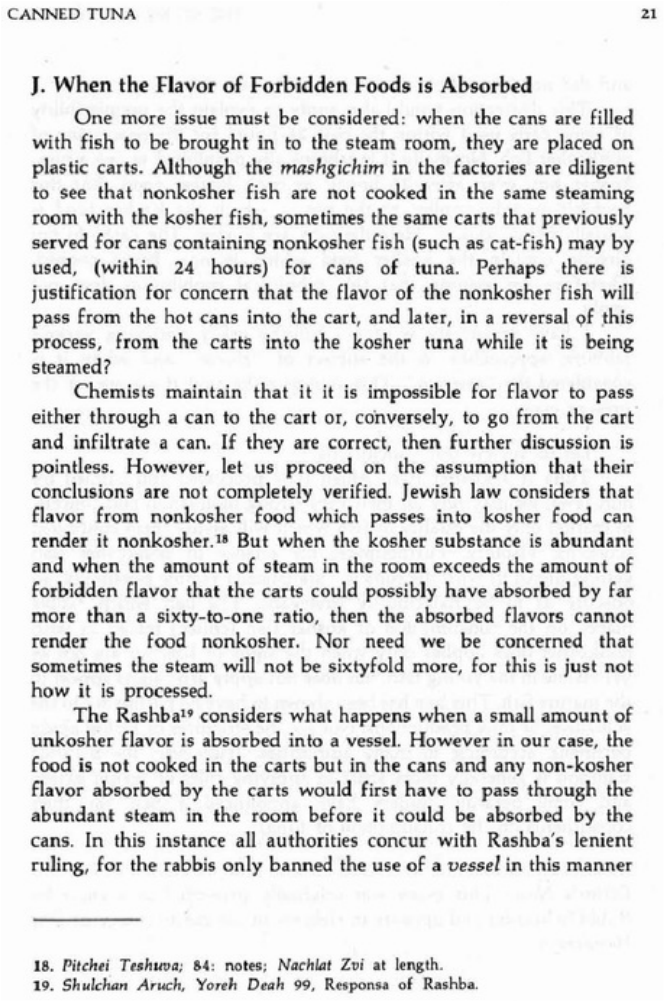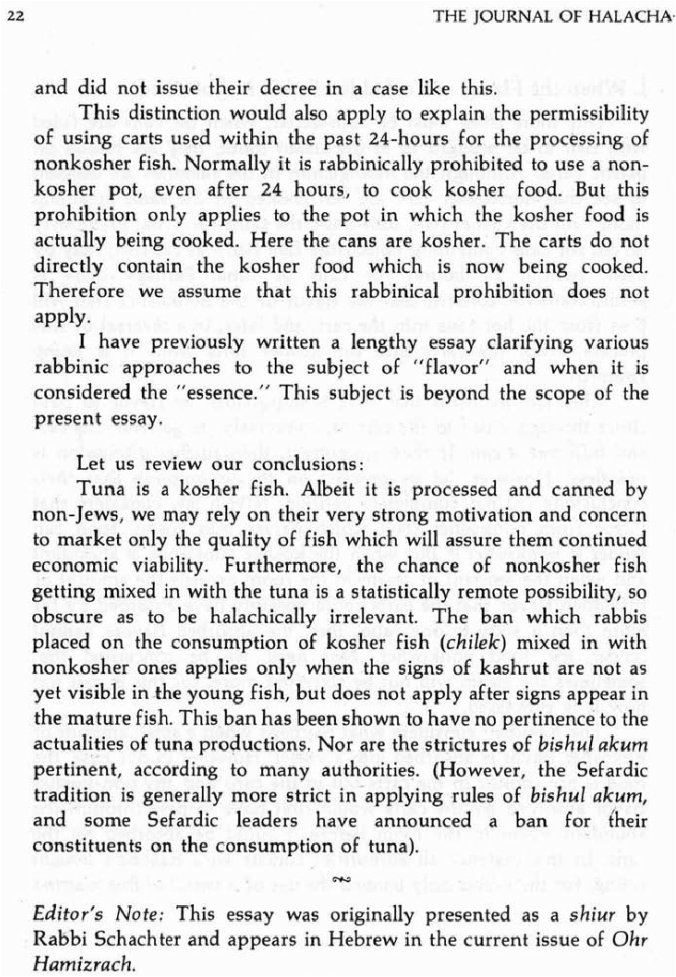Is Canned Tuna Kosher? Rabbi Herschel Schachter
|
Is Canned Tuna Kosher? Rabbi Herschel Schachter - facsimile of article in Tradition below
Whether one is permitted to use canned tuna is a question which has been discussed in Halachic circles for a number of decades. In order to be Kosher, a fish must have fins and scales; tuna unquestionably does have fins and scales and is a Kosher fish. Nevertheless, by the time the consumer opens the can, there is absolutely no evidence of this. For this reason, several Halachic authorities, including Rav Henkin [Kol Torah p.29 1964. HaPardes 1966 p.33] forbade consumption of canned tuna unless there is a Mashgiach T’midi (permanent Jewish supervisor) at the place of manufacture to inspect and assure that the fish going into the cans do qualify as Kosher. Others, on the other hand, have taken a more lenient position on the question. The purpose of this paper is to explain the lenient position (which, in practice, is relied on to some extent by all those who certify the Kashrus of tuna fish). Our discussion will address the following topics: A) Since Rav Henkin z.I. already forbade consumption of tuna canned without the constant supervision of a Kashrus inspector, is anyone entitled to permit it? B) Is there a requirement to examine each fish before consumption, to confirm that it has fins and scales? C) Can one rely on Gentiles to make this inspection? What weight is to be given to the fact that the Gentiles have established a system which is followed meticulously and does not allow for error? D) Can we rely on the "majority" (rov)? In other words, since most fish caught in the net are tuna, can we rely on that? Does it matter how much of a "majority" exists? E) What questions arise in the processing of the fish? Does the issur of bishul akum have to be taken into consideration? This paper will discuss only the Halachic ramifications of processing the fish, and does not address the question of the oils or other products added to the fish. A. When one Authority proscribes: - There are those who argue that, since Rav Henkin issued his prohibition concerning tuna some twenty-five years ago, no other scholar is entitled subsequently to permit it. The Gemara (Avoda Zara 7a) teaches that - One who seeks a ruling from a posek who forbids the matter in question, may not seek a ruling from another authority who will permit it. On this theme, the Shach rules [YD 242:54] - Even after the fact, where a second authority was consulted and allowed it, the matter remains proscribed. However, it is extremely important to understand that the rule stated above that one rabbi may not permit that which his colleague has banned is totally irrelevant here. It holds true only when the latter authority would rule on the very same object or deed that his colleague has proscribed. But when the object or deed in question is not the one that the preceding authority ruled on, then of course the latter may state his finding on the situation. [Rama: - but in any case, who can make the erroneous statement that the second posek may not allow it? If so, when a chacham errs in ruling on any issue, the error will remain for all time, for no authority will be empowered to rule otherwise. Another thing: - Halachic literature is replete with references to Rashi who enlightened Israel and on whose wisdom the world stands. Nevertheless there are many instances where Rashi prohibits and Rabbenu Tam, his grandson, rules leniently] Obviously, the cans [mgr and the circumstances] that Rav Henkin, Z.L. banned no longer exist and are not the cans presently in question. Secondly, let us note that the lenient view on this matter does not originate from myself but is a ruling received from our teacher, Rav Yosef Dov Soloveitchik, who takes the lenient view in this matter. [Rabbi Soloveitchik forcefully reiterated this position and was publicly heard to declare that he considers canned tuna permissible] Similarly, it is known that Hagaon Rav Aharon Kotler, Z.L. ruled that one may eat Bumble Bee tuna (which at that time had no rabbinic supervision whatsoever). Many other Halachic authorities took a similar position regarding canned tuna. I would therefore like to clarify this opinion, held by my teacher, Rabbi Soloveitchik, and all those who concurred with his ruling. B. Characteristics of Kosher Fish Repeated examination of tuna has ascertained that it has fins and scales and is therefore a Kosher fish. The rule concerning fish is unlike that of birds, whose Kosher status is restricted to those birds concerning which the Jewish community has a tradition of Kashrus. [Responsa Zichron Yehuda (son of Rosh); Responsa of the Frankfurter Dayan, Menachem Meishiv 31; Minchat Yitzchak 3:71. See also Darkei Teshuvah on Yoreh Deah 73:4 who cites Responsa Beit Shlomo: - While we find rabbinic injunctions banning the partaking of certain Kosher species of fowl because they bear a strong resemblance to species which are non-Kosher, we need not be so stringent regarding fish and ban something which the Torah and our sages, Z.L. specifically allowed.] Many years ago, an objection was raised concerning one variety of tuna, the skip jack, which is lacking scales on its tail, near the fins, and near the jaw. Now, the Ramo (Yoreh Deal: - 83, 1,) specifically recommends that we be strict regarding finding scales in just these places. However, the Kaf Hachayim (ibid., no. 3) brings the view of Pri Megadim and other poskim that this strict position of the Ramo refers only to a fish which has but one scale, the fear being that somehow this scale is not really from the fish itself but became attached by accident. In such a case, we must check the location, to be sure that at least the scale is in the strategic place. But when a fish has many scales, it is of no consequence on which part of the body they appear. In fact, the skip jack tuna has numerous scales on its body. Many years ago, Rav Soloveitchik was shown this fish and, after personally checking its scales, declared it to be Kosher. C. Must fish be examined to assure Kashrut? There are those who would ban canned tuna on the grounds that no fish is deemed to be Kosher unless the existence of fins and scales has been ascertained by direct examination. Since the fisheries in Puerto Rico, where the fish are processed, have no Jews present to check each fish individually for these characteristics, the task being performed by the non-Jewish workers, one could argue that there is no basis for regarding the processed fish as Kosher. This rationale is obviously incorrect, however, for we rule that - where it [the fish] is currently devoid of them [fins and scales] and will eventually grow them, it may be eaten. [Avoda Zara 39a] Clearly, it is impossible to examine fins and scales that are not yet in existence. How then does the Gemara permit the consumption of this fish? We must conclude that the need to ascertain the existence of fins and scales is merely a prerequisite for establishing the Kashrus of a fish species. Once this has been done and we recognize a fish as belonging to such a species it is Kosher despite the fact that the particular fish in question itself has never been examined for these characteristics. [See Darkei Teshuvah 83: - he notes that according to Minchat Chinuch (Mitzvah 154), one who ate a fish and examined it only for the presence of fins but did not search for scales, has violated the precept of inspecting a fish for its Kosher traits. Darkei Teshuveh, however, comments that this applies only to a fish which is not recognizable to us as being of a Kosher species. But if we discern that it is of a Kosher species, then all concur that it is unnecessary to check it for Kosher characteristics on every occasion. Darkei Teshuvah 79 reiterates this position when dissenting from Sefer HaChinuch (Mitzvah 153), who states that it is a positive precept to examine an animal for its Kosher characteristics. One who is untrained in discerning these Kosher traits and did not examine the creature, but instead relied on the fact that he observed that it had one Kosher characteristic and ate from it, has violated the positive precept of checking for Kosher traits, even if later he finds out that it was indeed Kosher. To this, Darkei Teshuvah adds This is true only of creatures unknown to us till now which are not easily recognized as being members of a Kosher species. But an animal clearly discernible as being part of a Kosher species need not be examined regularly for Kosher traits.] [See Beit Shmuel in his commentary to Avoda Zara 39a, who cites Rambam in Moreh Nevuchim that the Kosher traits identify the fish as belonging to a Kosher species. While Ramban (in his commentary to Torah) views the Kosher traits as prerequisites for establishing the Kashrus of each fish, Chasam Sofer refers to a question raised by a correspondent: - Our rule is that if a fish will eventually grow the fins and scales it is deemed Kosher, even prior to the growth of the Kosher characteristics. How can Ramban say that fins and scales are prerequisites to Kashrus? Refer there for his resolution of this problem (Chasam Sofer, Yoreh Deal: - 75). At any rate, no matter how we resolve Ramban, Darkei Teshuvah's principle remains evident, viz., that it is impossible to consider the inspection of the fins and scales as the factor which determines the Kashrus of the fish. Rather, as long as the fish is recognized as belonging to a Kosher species. we may eat it without inspecting it for fins and scales.] Still, even though each fish need not be examined as long as we know that it belongs to a Kosher species, the question arises that canned tuna is a total unknown to us, for all traces of fins and scales have been removed along with the skin. How can we be sure that the can contains tuna? Can we rely on the inspection of the Gentile factory workers in Puerto Rico? We know that the testimony of a non-Jew in Kashrus matters is generally not accepted. Let us, however, consider the question from a different vantage point. D. No craftsman willingly jeopardizes his livelihood. It is a well-established Halachic principle that although we may not rely on the evidence of a non-Jew relevant to the Kashrus of a food item, yet if can be certain that he is telling the truth, in certain cases we may rely on him. Jewish law operates on the principle that every individual, including the non-Jew, is concerned with maintaining his reputation as a reliable craftsman or worker; it is not worth it to him to endanger his livelihood by selling an object under false circumstances since thereby he can ruin his entire reputation and business. This principle is clearly pertinent to our discussion. The Gentile fishermen on the fishing boats meticulously seek to limit their catch not only to tuna but to those specific tuna known as albacore and skip jack. They do this because the canneries will not buy any other type of fish from them, nor any other kind of tuna other than the two Species enumerated. The canneries are not motivated here by considerations of Kashrus, for all species of tuna are Kosher. They have more pragmatic concerns in mind. The canneries are set up to process these two species of tuna with maximum efficiency; they are therefore unwilling to take in any other type of tuna. For purposes of quality control, they will not permit the introduction of albacore whose appearance differs from the rest. Thus, while it is true that a heathen may not bear witness in question of Kashrus, nevertheless, we may rely on these Gentile fishermen to verify the Kashrus of the fish, not as witnesses, but as a simple truth of human nature. An artisan will not do anything to jeopardize his means of livelihood. They are always careful to use nets especially made to catch these types of fish. They examine the fish when the catch is made. Whatever they cannot sell to the cannery they throw back into the ocean to make more room on the boat for the saleable fish. The fishermen examine their catch once again on shore prior to its sale. The buyers examine the fish before purchase to assure that the fish is the type necessary for production. They check once again prior to processing in the cannery. We must emphasize that motivation for their fastidiousness is not fear of exposure and ensuing penalties, so that the argument might be made that where profits far exceed penalties, they would take the risk of using non-Kosher fish. Rather, their procedures are designed specifically for two types of tuna and it is in their own interest to assure that no other fish enters their machinery. In addition anyone who has ever visited the canneries is aware of the meticulousness with which the workers eliminate any non-Kosher species because their presence has a detrimental effect on the other, Kosher fish. [See Yabia Omar (volume 5, Yoreh Deah 9) who concurs with those who rely on the certainty that a craftsman will not jeopardize his livelihood, to establish the status of the oil (that the fish is packed in) as Kosher and contains no oil from a non-Kosher species of fish (ibid, 4), while rejecting this very same rationale for identifying the species of fish itself (ibid, 3). The distinction is difficult to understand, for the Gemara in Avoda Zara 34h states specifically that one may rely on this law of human nature to identify a fish as Kosher. No mashgiach has ever found any non-Kosher fish in a cannery. in fact, they have never found in the factory any other species of tuna other than albacore, skip jack, or yellow fin. This case is similar to the case in the Talmud where we rely on the certainty that a craftsman will do nothing to jeopardize his livelihood. We are forced to conclude that the author of Yabia Omer is referring to a situation where this consideration is non-existent, where profit maximization is achieved without segregating one particular species. But where business concerns dictate that only one species of fish be processed, then reliance on the above rule of behavior is beyond dispute. We know it to be true after many years of having mashgichim visit the factories and substantiate the facts as we have stated.] E. The Power of “Majority” (rov). Despite the great care taken to assure that only albacore and skip jack enter the tuna cannery, we must admit of the possibility, however remote, of some other fish becoming mingled with the catch and inadvertently being processed with the Kosher fish. Can we nevertheless claim that each can of tuna may be assumed to contain only Kosher fish, based on the principle that since the overwhelming majority of the fish are Kosher, each can is entitled to the presumption that it belongs to this ”majority" (rov)? While logically this is an attractive and compelling-position, and we will discuss it below more fully, we do have to consider the trenchant argument of Rivash (Responsum 192) that since the Torah specifically instructs us to determine Kashrus of fish via physical inspection of fins and scales, this establishes an obligation to examine each fish individually and precludes our attributing it to one of the prevailing species without proof. However, as we shall see in the discussion of ”prevailing probability" below, even Rivash would concur with a lenient position where the possibility of finding an non-Kosher fish mixed in is so very remote. F. Different types of prevailing probabilities (rov): Since in actual practice we are relying on the presumption that almost all fish being processed in the tuna canneries are tuna and therefore we may assume that the can contains only tuna, we must examine the Halachic legitimacy of such a position. Does Jewish law permit our acting on the strength of a logical assumption, absent actual physical inspection? It is clear from the Gemara that there are various categories of prevailing probabilities" (Rov): 1. A slim majority such as where there is only about a 51% chance of one probability over its alternative. In this case, where a “thin" probability is pitted against a status quo situation (chazakah), the two are considered to be equally weighted (Tosafot, Avoda Zara 41b). The reason that prevalent probability normally outweighs the status quo rule is that the former serves to indicate what the facts of the situation are while the "status quo" merely asserts a rule of conduct to be followed and can not ascertain the facts. But we only accept the "prevalence" as a logical necessity where prevalence" is strong. But where the majority forces involved just barely outweigh the opposing probability (such as a majority of 51%), it is considered no better than a mode of behavior, (chazakah) and both sides of the case are given equal weight. ll. A strong “prevailing probability" (such as where there is a 70% or 80% probability factor)! [See Tosafot Kiddushin 8oa s.v. Smach Miutah L'Chazakah.] III. An overwhelming majority, which renders the alternative remote (such as a probability factor of 9096). The distinction between ll and Ill above may be found in Chidushei Ramban and in Milchamat to the first perek of Chulin; it is cited as being the rule in Yareh Deah. (39:1) and Shach, (ibid, no. 2): - Wherever direct examination can clarify the situation, these means should be employed and we may not attribute the facts to the ”prevailing probabilities" when they are of category ll. But when category 111 is what we have, then examination is unnecessary. lV. Topping the list is a prevailing probability of such predominance that the alternative is one in a thousand. In such a case, Chasam Sofer lays down the principle [Response Chatum Safer, Yareh Deah 338, cited in Pischei Teshuvah Yareh Deah 357:1] that this factor is so negligible that normal people do not reckon with it at all. In such a case we conclude that "G-d watches over fools," i.e., the danger is so minimal that doing it violates no precepts. [Chasam Sofer's principle contradicts that of Maharam Schick (Yareh Dealt 244) who writes regarding the contemporary need for Metzitza: - Even when prevailing medical knowledge tells us that the risk to the child is one in a billion we may violate the Sabbath for the child. Most authorities concur with Chasam Sofer.] Clearly, a probability of one in a thousand is considered so negligible as to be non-existent, and thus absolves us from the precept of examining the fins and scales of each fish individually. [See Responsa of Rivash who says this explicitly - Since the Torah commanded us to examine the characteristics of each bird to ascertain that it is not one the 24 non-Kosher species... we must therefore be alert for any of the 24 species even though each constitutes a small minority except for the bearded vulture and the osprey which are completely absent from inhabited areas. as Ramban states: - "They are found only in deserts and extremely remote islands at the edge of civilization." But where the possibility of their appearance exists, then each bird is suspect, as we say by animals "he must be capable of recognizing a wild ass," despite the fact that the wild ass represents an insignificant percentage of the total Kosher animal population.] See responsa Har Zvi Y.D.: - 74 who discusses a lenient reading of Rivash in the context of his own lenient ruling. The first two reasons he adduces for his position also apply to the subject under discussion: A) Where the non-Kosher species is never to be found, even Rivash himself concurs that we rely on the prevailing probability (as cited in note 12, regarding the bearded vulture and the osprey). B) Rivash's intent was to indicate that we should not rely on the prevailing probability in a situation where the Torah specifically directs "You shall segregate," which it does in connection with the examination of birds. This shows that inspection of birds is a positive precept.f Consequently, wherever the possibility of inspecting the creature exists, one is obliged to check and segregate the non-Kosher birds.(Rivash implies the same in Responsum 191); but where examination is completely impossible, then we rely on probability. The same logic employed by the author of Har 20? in the case of birds applies as well to the tuna situation. H. The Ban on Chilek and Rashi’s Opinion: There is another theoretical basis for issuing a ban on con- sumption of canned tuna. ln Avoda Zara 35h the Mishnah states: - The following are items of non-Jews which are forbidden. . . and chilek." Discussing this on p.39a, the Gemara explains, "Why is Chilek banned [after all, it is a Kosher fish]? Because a conglomeration of fish comes up with it..." Rashi (ibid 35b) sees the rationale for the ban in that - non-Kosher fish similar in appearance to chilek are brought in the nets with it; therefore, it makes no difference whether it is shredded or not. We must be wary of the one [non-Kosher] fish in a thousand among them which resembles [chilek] This Talmudic discussion would seem to indicate that despite our earlier rationale for permitting fish to be eaten without inspection since there is virtually no chance of its being non-Kosher, there does nevertheless seem to be a rabbinic requirement for such inspection when Kosher and non-Kosher fish are caught intermingled in the nets. This too, however, is a misleading impression. Careful study of the wording of the commentaries and authorities on the subject reveals that although all define chilek as Rashi does, the phrase "One in a thousand" does not appear in any other commentary, including Rashi's own commentary on Rif with the exception of the Or Zarua: - 196. Clearly, most commentaries disagree with.Rashi on this point and hold that when the probability is merely one in a thousand not even a rabbinic obligation to examine each fish exists. There is a further point which I consider to be the primary rebuttal; Rashash in Succah 18A discusses the Kosher fish called Shtinkes" in the vernacular, and notes: These fish too are frequently netted intermingled with small non-Kosher fish which are indistinguishable... Everyone assumes them to be Kosher, and no one voices any objections, may G-d forgive us. Nevertheless, he does permit consumption of this fish, concluding that - we can resolve this by saying that Rashi in Avoda Zara defines Tzachante as chilek, etc. [It has no fins and scales but will eventually grow them and should therefore be Kosher. Why did they ban them? Because a conglomeration of similar looking non-Kosher fish are usually netted with them...] We derive from here that the ban [On chilek] was only decreed when the fish is immature and its fins and scales are not grown in yet. At that stage it is indistinguishable from non-Kosher fish. But once its fins and scales have grown in, it is easily recognized. In Yoreh Deah 114:16 the Shack concurs with this position. Small fish without fins and scales which well eventually grow them, may be eaten according to Rashi, to Rambam in his commentary to the Mishnah, and also to Bartenuro. The implication is that other small fish which have no scales may be eaten, for they are distinguishable from non-Kosher fish. All Rishonim define the status of Chilek in the same say; namely that the ban applies only prior to the inevitable appearance of scales in the mature fish. Similarly Kaf Hachayim on Yoreh Deah concurs with Shack. See also the text of Rambam's Commentary on Mishnah: - We ban it because it is netted with similar species which are non-Kosher and which are easily confused with it and very few people can distinguish it. However, it must be examined. What needs clarification is why chilek is listed in the Mishnah with items belonging to Gentiles. Even if it belongs to Jews it is forbidden! The same reasoning applies in our case. Tuna are caught when mature, and their scales are easily discernible; they are readily distinguishable as tuna. Consequently, the ban on chilek as discussed by Shack and all Rishonim has no bearing on their status. [See Responsa Menachem Meshiv (ibid.): - The tuna that we eat are very large and are totally unlike chilek which are immature, not having developed their scales. It is for this reason that they are indistinguishable from non-Kosher fish.] Furthermore, there are experts who are quite capable of distinguishing the Kosher chilek from non-Kosher fish and the Talmud specifically permits them to be eaten: - Chilek belonging to an expert [non-Jew] may be eaten... (Avoda Zara 39). The realities of the tuna industry conform to these guidelines. For their own financial interests fish processors repeatedly examine the fish intake of the cannery to assure that they are processing only albacore tuna which conforms to the appearance of standard albacore, as explained above. Moreover, the Mishnah is referring to a case where we are certain that small non-Kosher fish are netted along with the Kosher fish. It is only here that Rashi maintains the rabbis banned the entire conglomeration even if the Kosher species is a thousandfold more numerous than the non-Kosher one. But in our case, there is no certainty at all that the non-Kosher species is present in the cannery. On the contrary, the fishermen, the factory workers and the factory owners meticulously seek to package only albacore matching the industry-wide standards. Consequently, it is erroneous to draw conclusions about the Halachic status of tuna based on the precedent of the chilek ban. l. The problem of Bishul Akum Perhaps the tuna should be forbidden because it is cooked in the factory by Gentile workers, thus making it bishul akum? Minchat Yitzchak (3:26:6) rules leniently, based on two considerations: - The tuna is cooked in the factory by a work force whose identity is unknown to the consumer. (Editor's note: - the reason for the rabbinic edict forbidding consumption of food cooked by a non-Jew is to discourage social intercourse, which could lead to intermarriage - an unlikely result when the cook and the consumer remain unknown to each other). He also notes that the fish is not actually cooked but rather steamed; some latter-day Halachic authorities hold that steaming" is equivalent to “smoking" which is not included in the ban on bishul akum (Darkei Teshuvah: - 14). Rabbi Ovadiah Yosef [Responsa Yabia Omer 5, YD 9] considers canned fish permissible for the second reason alone and omits the first reason. However, his discussion applies only to sardines, for he was told by experts knowledgeable in the methods of processing sardines that prior to their being cooked in cans they are steamed, cooking them slighty until they are fit to be eaten. Thus they are not included in the edict of Bishul Akum, for they were already rendered fit for consumption by the steaming process, prior to being cooked in the cans. But tuna, which is cooked in cans in hot water without any prior steaming, according to him may not be eaten. [See Shevet Halevi 6: - 108:6 who writes that currently the manner in which sardines are processed has been changed. They are no longer salted prior to being prepared but are placed in cans containing oil and are steamed after the cans are sealed shut. The steam causes the oil to boil and the sardines are thus cooked in the oil. Therefore, the sardines should be included in the ban on Bishul Akum... Those who rule leniently rely on the principle stated in some sefarim that the cooking done in a factory where the food is thus being prepared for tens of thousands of people is not included in the ban of bishul akum, where the intent was to discourage intermarriage. However, I heard directly from the Chaon lsh, 1.1. that we should be stringent in this matter] However, other rabbis dissent [See Beit Avi 3:115] and do permit the use of canned tuna; the rationale is not that in factory production the customer never meets the cook, but rather that steaming is considered equivalent to smoking. Apparently the cooking process varies from place to place. Reliable mashgichim (Kashrut supervisors) report that the tuna sold here in America is already edible after the first steaming. Reliance on this rationale is a basis for being lenient concerning this ban. [See text of Yabia Omar 3 and Minchat Yitzchak 4:81. See also Shabbat 51a that the law may be different for a "prominent person." Note the discussions in Shevet Levi 3, Minchat Chinuch, Shach, (lbid. 152), responsa Divrei Yosef, Aruch Hashulchan, and Tosafot to Shabbat 51; Chasam Sofer Responsa Orach Chaim 15] J. When the Flavor of Forbidden Foods is Absorbed One more issue must be considered: - when the cans are filled with fish to be brought in to the steam room, they are placed on plastic carts. Although the mashgichim in the factories are diligent to see that non-Kosher fish are not cooked in the same steaming room with the Kosher fish, sometimes the same carts that previously served for cans containing non-Kosher fish (such as cat-fish) may by used, (within 24 hours) for cans of tuna. Perhaps there is justification for concern that the flavor of the non-Kosher fish will pass from the hot cans into the cart, and later, in a reversal of this process, from the carts into the Kosher tuna while it is being steamed? Chemists maintain that it it is impossible for flavor to pass either through a can to the cart or, conversely, to go from the cart and infiltrate a can. If they are correct, then further discussion is pointless. However, let us proceed on the assumption that their conclusions are not completely verified. Jewish law considers that flavor from non-Kosher food which passes into Kosher food can render it non-Kosher. [Pischei Teshuva; 84: - notes; Nachlat Zvi at length] But when the Kosher substance is abundant and when the amount of steam in the room exceeds the amount of forbidden flavor that the carts could possibly have absorbed by far more than a sixty-to-one ratio, then the absorbed flavors cannot render the food non-Kosher. Nor need we be concerned that sometimes the steam will not be sixtyfold more, for this is just not how it is processed. The Rashba [Shulchan Amch, Yoreh Deal: - 99, Responsa of Rashba] considers what happens when a small amount of non-Kosher flavor is absorbed into a vessel. However in our case, the food is not cooked in the carts but in the cans and any non-Kosher flavor absorbed by the carts would first have to pass through the abundant steam in the room before it could be absorbed by the cans. In this instance all authorities concur with Rashba’s lenient ruling, for the rabbis only banned the use of a vessel in this manner and did not issue their decree in a case like this. This distinction would also apply to explain the permissibility of using carts used within the past 24-hours for the processing of non-Kosher fish. Normally it is rabbinically prohibited to use a non- Kosher pot, even after 24 hours, to cook Kosher food. But this prohibition only applies to the pot in which the Kosher food is actually being cooked. Here the cans are Kosher. The carts do not directly contain the Kosher food which is now being cooked. Therefore we assume that this rabbinical prohibition does not apply. I have previously written a lengthy essay clarifying various rabbinic approaches to the subject of "flavor" and when it is considered the "essence.” This subject is beyond the scope of the present essay. Let us review our conclusions: Tuna is a Kosher fish. Albeit it is processed and canned by non-Jews, we may rely on their very strong motivation and concern to market only the quality of fish which will assure them continued economic viability. Furthermore, the chance of non-Kosher fish getting mixed in with the tuna is a statistically remote possibility, so obscure as to be Halachically irrelevant. The ban which rabbis placed on the consumption of Kosher fish (chilek) mixed in with non-Kosher ones applies only when the signs of Kashrus are not as yet visible in the young fish, but does not apply after signs appear in the mature fish. This ban has been shown to have no pertinence to the actualities of tuna productions. Nor are the strictures of bishul akum pertinent, according to many authorities. (However, the Sefardic tradition is generally more strict in applying rules of bishul akum, and some Sefardic leaders have announced a ban for their constituents on the consumption of tuna). Editor's Note: - This essay was originally presented as a shim by Rabbi Schachter and appears in Hebrew in the current issue of Ohr Hamizrach |
